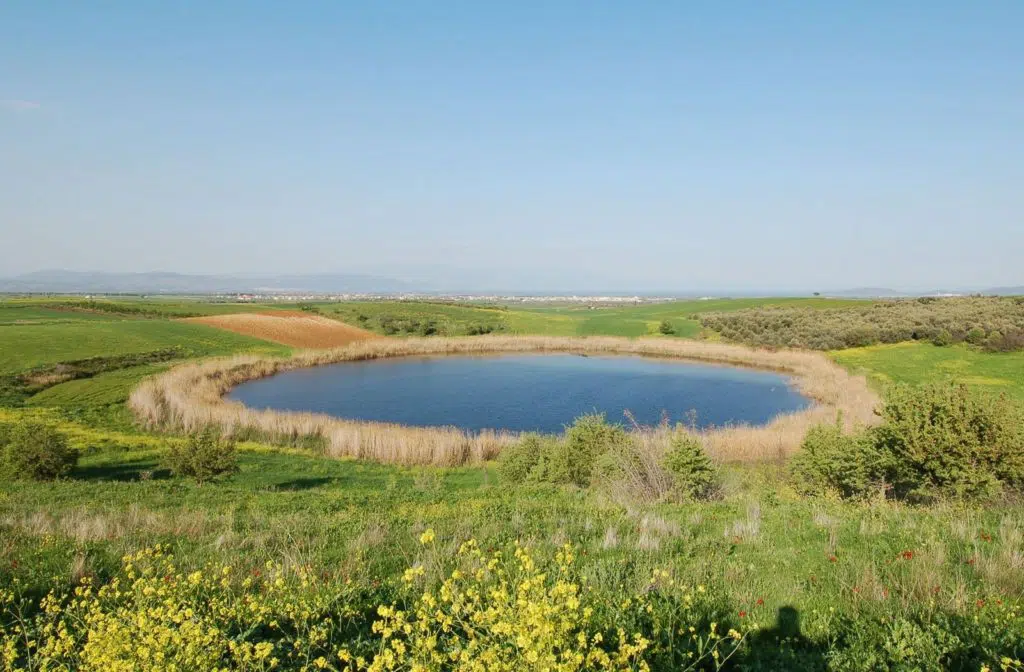
The twin lakes, known collectively as Zerelia, in Central Greece are rare examples of bodies of water that were formed from the cataclysmic impact of a meteorite.
Located just a few kilometers outside the city of Volos and four kilometers (2.5 miles) from the town of Almyros, the two lakes are only 250 meters from each other but were created by the tremendous impact of the space rock that catapulted through the Earth’s atmosphere.
According to scientists, approximately 10 thousand years ago, a meteorite hit the Earth, split into two and created two twin craters, which filled with water — and the lakes are still there today.
Lake Zerelia’s unusual origin from a meteorite crash
Only a few meters from the lakes is a small hill on which a prehistoric settlement was located, which was inhabited until the Bronze Age.
In addition to their archaeological interest and meteorological origin, the twin lakes have formed important wetlands habitats for many species of birds, such as white storks, green-headed ducks, coots, egrets and others.
The largest lake has a diameter of 250 meters and a depth of about eight meters, while the smallest has a diameter of 150 meters and a depth of about six meters. The bottom has the shape of a plate.
The lakes were originally considered to be of volcanic origin, or karstic doline.
In December 2010, however, researchers Evangelos Lagios and Dietrich Volker J. found partially molten zirconium at the bottom of the lakes — the melting of which requires temperatures higher than 1,400 – 1,800 degrees Celsius.
Because such high temperatures are not found in magmatization processes of volcanoes or as part of the metamorphic phenomena that take place in the Earth’s crust, the researchers suggested a meteorite impact as the reason behind the creation of the almost perfectly-round lakes.
According to Lagios and Volker, this collision would have taken place during the Holocene era, between 12,500 to 8,000 years ago; the probable size of the meteorite is estimated at 10 to 30m and this phenomenon is unique in Greece.
Findings from the iron age in Greece
The hill located in the area was explored by the archeological team of Professor of Eurasian Archaeology H. Reinder Reinders from the Netherlands Institute at Athens.
In a surface excavation of the soil, ceramic fragments from the Bronze Age were found. According to archaeologist Dimitris Theocharis, a temple dedicated to Athena Itonia is located in the bottom of one of the two lakes — and appears only when the level of the lake falls.
However, the Reinders excavation team disputes this hypothesis.
In 2005, systematic research was started by the Department of History, Archeology and Social Anthropology of the University of Thessaly and the 13th Ephorate of Prehistoric and Classical Antiquities.
During the first year of this research, traces of pilings and clay floors were found, evidence that supports the existence of a house from the early Bronze Age.
Subsequently, it was found that a large part of the volume of the hill was formed by the intense residential activity during the Bronze Age, with continuous repair and reconstruction of houses made of clay and wooden stakes.
Archaeologists also discovered a pit with findings from several periods, with the newest of them being a silver coin of the Phocaeans that dates back to the beginning of the 5th century BC.
In general, the finds from Zerelia consist of fragments of pottery, clay flywheels, arrowheads and flint tools. The overall picture of the settlement shows a well-organized rural community that made the best use of the available natural resources.
See all the latest news from Greece and the world at Greekreporter.com. Contact our newsroom to report an update or send your story, photos and videos. Follow GR on Google News and subscribe here to our daily email!



